Corporation Law Case Study: Salomon, Gilford, and Daimler Cases
VerifiedAdded on 2021/05/31
|5
|945
|41
Case Study
AI Summary
This case study analyzes a corporation law scenario involving Industrial Machines Ltd and Roger, addressing the issue of whether Industrial Machines Ltd can sue Roger personally and the appropriateness of the Commonwealth Department of Industry's decision. The assignment explores the concept of a company as a separate legal entity, distinct from its shareholders, referencing the landmark case of Salomon v Salomon & Co Ltd. It discusses the implications of corporate veil, referencing cases like Daimler Co v Continental Tyre and Rubber Co and Gilford Motor Co Ltd v Horne. The application section applies these legal principles to the case, concluding that Industrial Machines Ltd cannot personally sue Roger, and the Commonwealth Department of Industry's decision was appropriate. The study underscores the importance of understanding corporate structure, shareholder liability, and the legal implications of corporate actions.
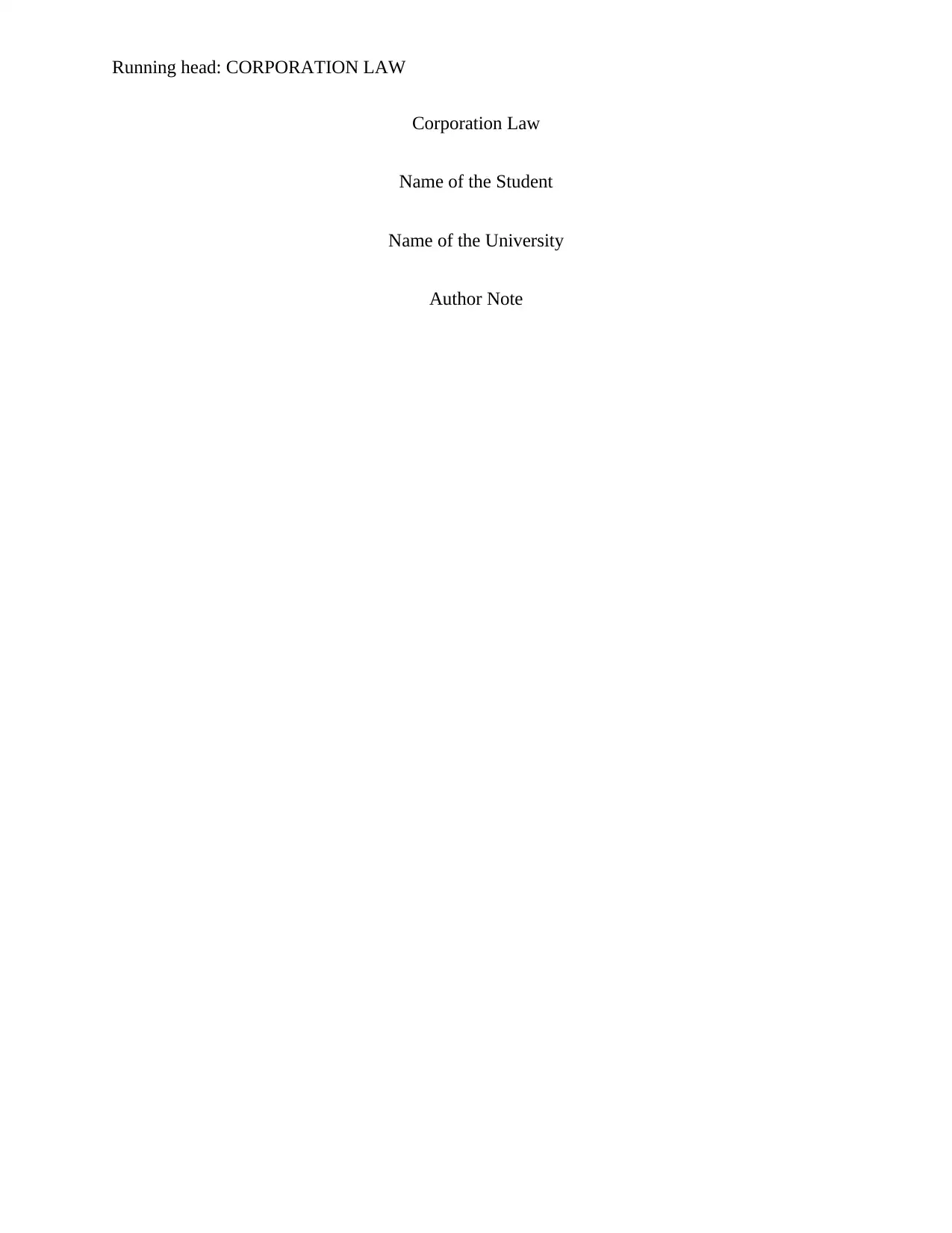
Running head: CORPORATION LAW
Corporation Law
Name of the Student
Name of the University
Author Note
Corporation Law
Name of the Student
Name of the University
Author Note
Paraphrase This Document
Need a fresh take? Get an instant paraphrase of this document with our AI Paraphraser
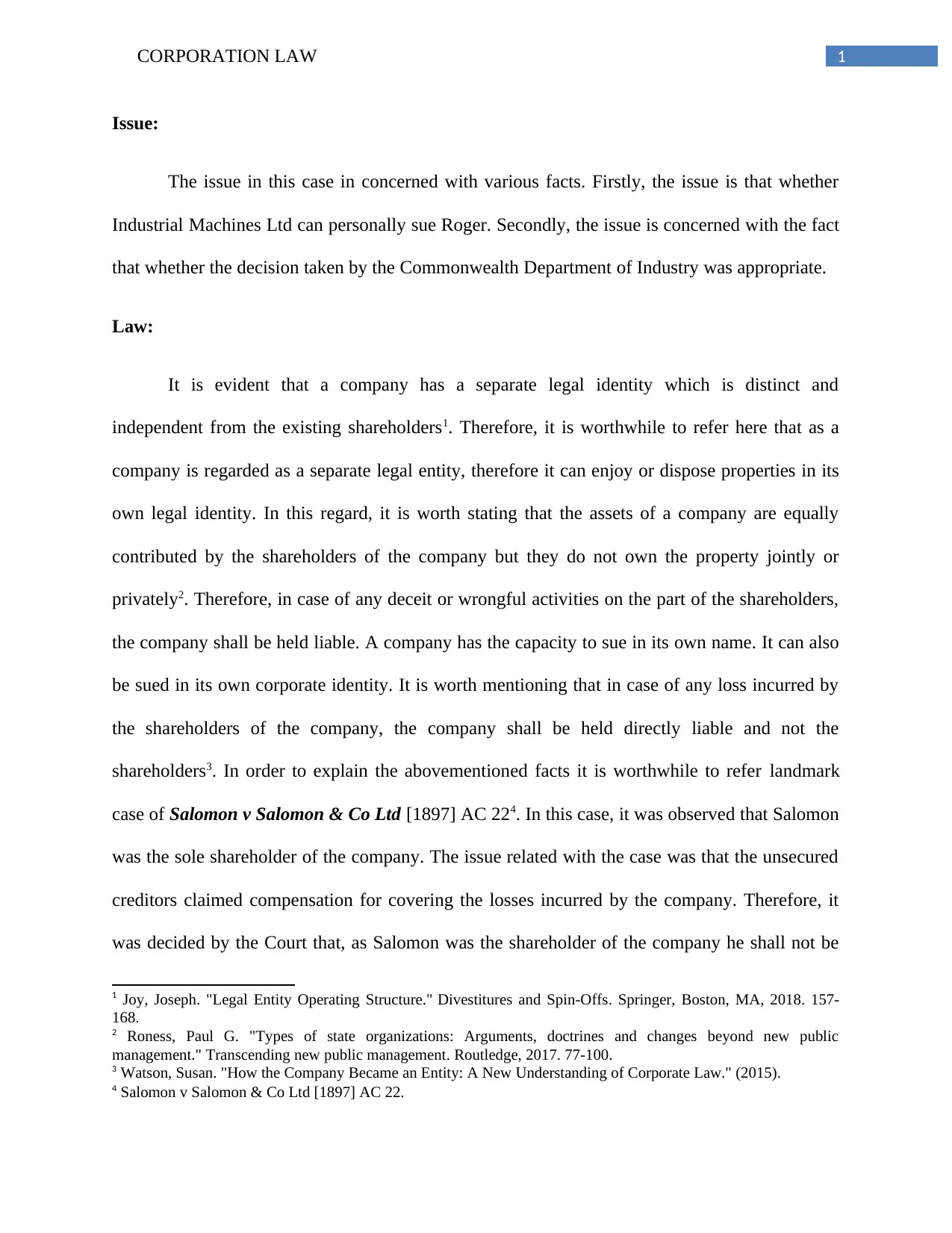
1CORPORATION LAW
Issue:
The issue in this case in concerned with various facts. Firstly, the issue is that whether
Industrial Machines Ltd can personally sue Roger. Secondly, the issue is concerned with the fact
that whether the decision taken by the Commonwealth Department of Industry was appropriate.
Law:
It is evident that a company has a separate legal identity which is distinct and
independent from the existing shareholders1. Therefore, it is worthwhile to refer here that as a
company is regarded as a separate legal entity, therefore it can enjoy or dispose properties in its
own legal identity. In this regard, it is worth stating that the assets of a company are equally
contributed by the shareholders of the company but they do not own the property jointly or
privately2. Therefore, in case of any deceit or wrongful activities on the part of the shareholders,
the company shall be held liable. A company has the capacity to sue in its own name. It can also
be sued in its own corporate identity. It is worth mentioning that in case of any loss incurred by
the shareholders of the company, the company shall be held directly liable and not the
shareholders3. In order to explain the abovementioned facts it is worthwhile to refer landmark
case of Salomon v Salomon & Co Ltd [1897] AC 224. In this case, it was observed that Salomon
was the sole shareholder of the company. The issue related with the case was that the unsecured
creditors claimed compensation for covering the losses incurred by the company. Therefore, it
was decided by the Court that, as Salomon was the shareholder of the company he shall not be
1 Joy, Joseph. "Legal Entity Operating Structure." Divestitures and Spin-Offs. Springer, Boston, MA, 2018. 157-
168.
2 Roness, Paul G. "Types of state organizations: Arguments, doctrines and changes beyond new public
management." Transcending new public management. Routledge, 2017. 77-100.
3 Watson, Susan. "How the Company Became an Entity: A New Understanding of Corporate Law." (2015).
4 Salomon v Salomon & Co Ltd [1897] AC 22.
Issue:
The issue in this case in concerned with various facts. Firstly, the issue is that whether
Industrial Machines Ltd can personally sue Roger. Secondly, the issue is concerned with the fact
that whether the decision taken by the Commonwealth Department of Industry was appropriate.
Law:
It is evident that a company has a separate legal identity which is distinct and
independent from the existing shareholders1. Therefore, it is worthwhile to refer here that as a
company is regarded as a separate legal entity, therefore it can enjoy or dispose properties in its
own legal identity. In this regard, it is worth stating that the assets of a company are equally
contributed by the shareholders of the company but they do not own the property jointly or
privately2. Therefore, in case of any deceit or wrongful activities on the part of the shareholders,
the company shall be held liable. A company has the capacity to sue in its own name. It can also
be sued in its own corporate identity. It is worth mentioning that in case of any loss incurred by
the shareholders of the company, the company shall be held directly liable and not the
shareholders3. In order to explain the abovementioned facts it is worthwhile to refer landmark
case of Salomon v Salomon & Co Ltd [1897] AC 224. In this case, it was observed that Salomon
was the sole shareholder of the company. The issue related with the case was that the unsecured
creditors claimed compensation for covering the losses incurred by the company. Therefore, it
was decided by the Court that, as Salomon was the shareholder of the company he shall not be
1 Joy, Joseph. "Legal Entity Operating Structure." Divestitures and Spin-Offs. Springer, Boston, MA, 2018. 157-
168.
2 Roness, Paul G. "Types of state organizations: Arguments, doctrines and changes beyond new public
management." Transcending new public management. Routledge, 2017. 77-100.
3 Watson, Susan. "How the Company Became an Entity: A New Understanding of Corporate Law." (2015).
4 Salomon v Salomon & Co Ltd [1897] AC 22.
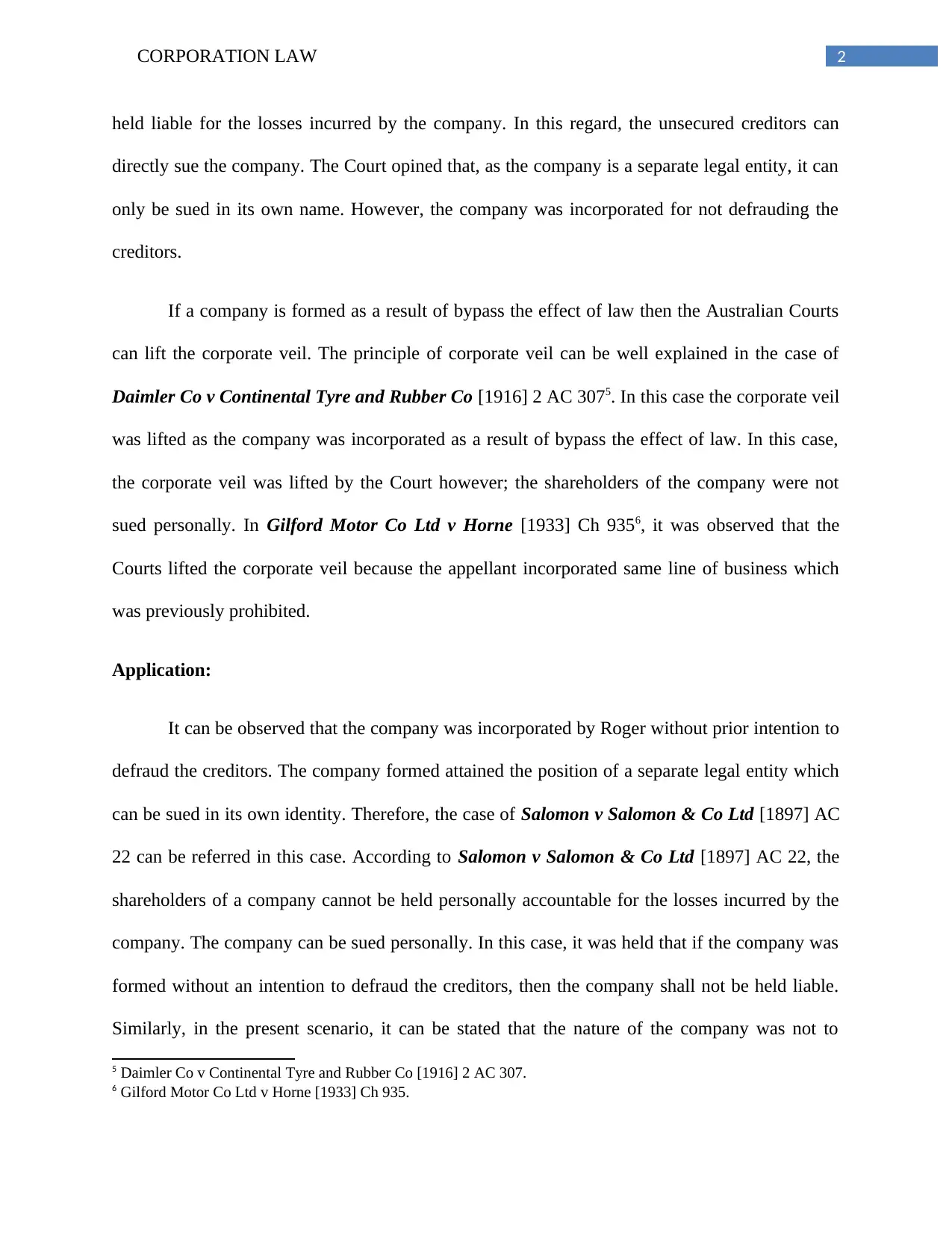
2CORPORATION LAW
held liable for the losses incurred by the company. In this regard, the unsecured creditors can
directly sue the company. The Court opined that, as the company is a separate legal entity, it can
only be sued in its own name. However, the company was incorporated for not defrauding the
creditors.
If a company is formed as a result of bypass the effect of law then the Australian Courts
can lift the corporate veil. The principle of corporate veil can be well explained in the case of
Daimler Co v Continental Tyre and Rubber Co [1916] 2 AC 3075. In this case the corporate veil
was lifted as the company was incorporated as a result of bypass the effect of law. In this case,
the corporate veil was lifted by the Court however; the shareholders of the company were not
sued personally. In Gilford Motor Co Ltd v Horne [1933] Ch 9356, it was observed that the
Courts lifted the corporate veil because the appellant incorporated same line of business which
was previously prohibited.
Application:
It can be observed that the company was incorporated by Roger without prior intention to
defraud the creditors. The company formed attained the position of a separate legal entity which
can be sued in its own identity. Therefore, the case of Salomon v Salomon & Co Ltd [1897] AC
22 can be referred in this case. According to Salomon v Salomon & Co Ltd [1897] AC 22, the
shareholders of a company cannot be held personally accountable for the losses incurred by the
company. The company can be sued personally. In this case, it was held that if the company was
formed without an intention to defraud the creditors, then the company shall not be held liable.
Similarly, in the present scenario, it can be stated that the nature of the company was not to
5 Daimler Co v Continental Tyre and Rubber Co [1916] 2 AC 307.
6 Gilford Motor Co Ltd v Horne [1933] Ch 935.
held liable for the losses incurred by the company. In this regard, the unsecured creditors can
directly sue the company. The Court opined that, as the company is a separate legal entity, it can
only be sued in its own name. However, the company was incorporated for not defrauding the
creditors.
If a company is formed as a result of bypass the effect of law then the Australian Courts
can lift the corporate veil. The principle of corporate veil can be well explained in the case of
Daimler Co v Continental Tyre and Rubber Co [1916] 2 AC 3075. In this case the corporate veil
was lifted as the company was incorporated as a result of bypass the effect of law. In this case,
the corporate veil was lifted by the Court however; the shareholders of the company were not
sued personally. In Gilford Motor Co Ltd v Horne [1933] Ch 9356, it was observed that the
Courts lifted the corporate veil because the appellant incorporated same line of business which
was previously prohibited.
Application:
It can be observed that the company was incorporated by Roger without prior intention to
defraud the creditors. The company formed attained the position of a separate legal entity which
can be sued in its own identity. Therefore, the case of Salomon v Salomon & Co Ltd [1897] AC
22 can be referred in this case. According to Salomon v Salomon & Co Ltd [1897] AC 22, the
shareholders of a company cannot be held personally accountable for the losses incurred by the
company. The company can be sued personally. In this case, it was held that if the company was
formed without an intention to defraud the creditors, then the company shall not be held liable.
Similarly, in the present scenario, it can be stated that the nature of the company was not to
5 Daimler Co v Continental Tyre and Rubber Co [1916] 2 AC 307.
6 Gilford Motor Co Ltd v Horne [1933] Ch 935.
⊘ This is a preview!⊘
Do you want full access?
Subscribe today to unlock all pages.

Trusted by 1+ million students worldwide
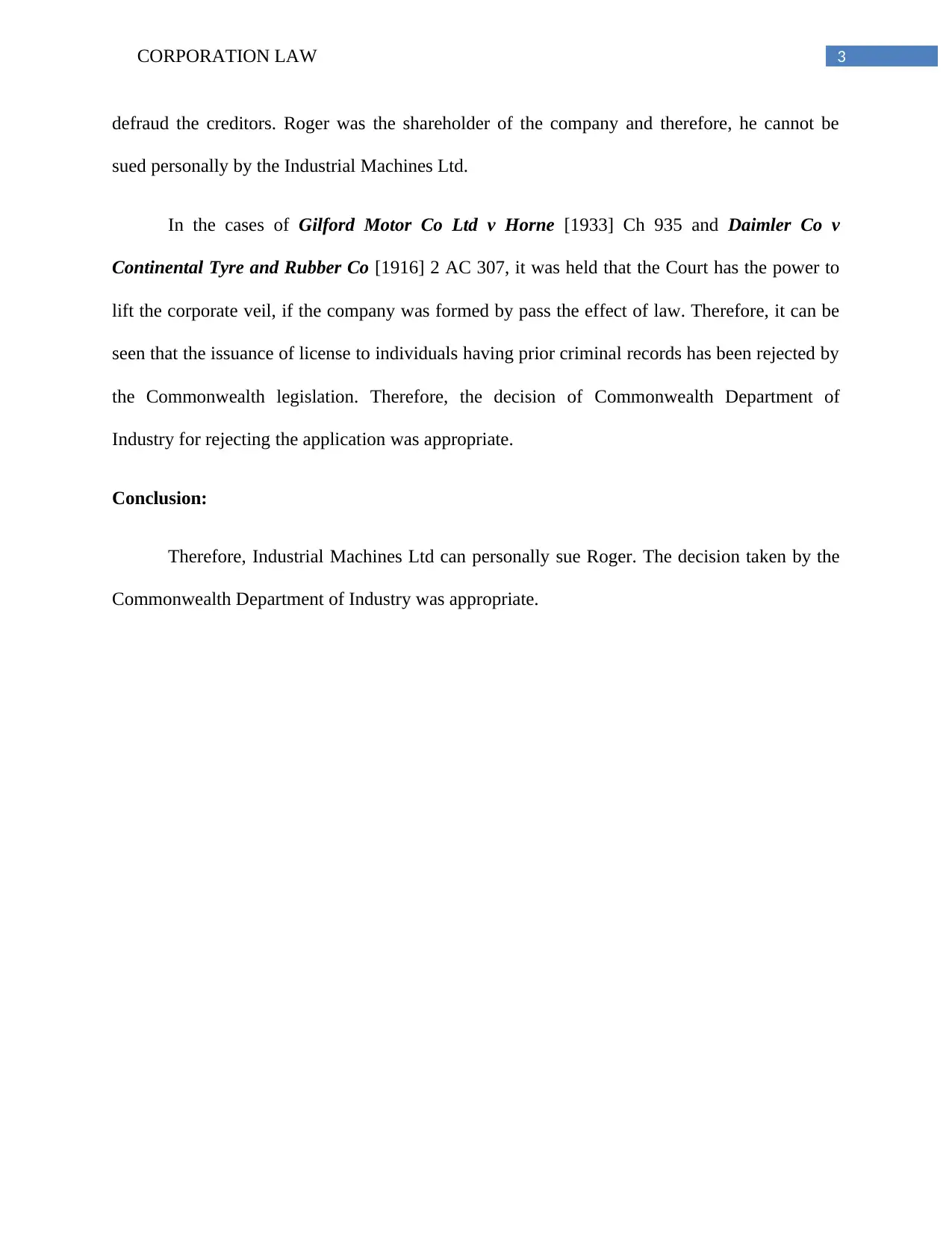
3CORPORATION LAW
defraud the creditors. Roger was the shareholder of the company and therefore, he cannot be
sued personally by the Industrial Machines Ltd.
In the cases of Gilford Motor Co Ltd v Horne [1933] Ch 935 and Daimler Co v
Continental Tyre and Rubber Co [1916] 2 AC 307, it was held that the Court has the power to
lift the corporate veil, if the company was formed by pass the effect of law. Therefore, it can be
seen that the issuance of license to individuals having prior criminal records has been rejected by
the Commonwealth legislation. Therefore, the decision of Commonwealth Department of
Industry for rejecting the application was appropriate.
Conclusion:
Therefore, Industrial Machines Ltd can personally sue Roger. The decision taken by the
Commonwealth Department of Industry was appropriate.
defraud the creditors. Roger was the shareholder of the company and therefore, he cannot be
sued personally by the Industrial Machines Ltd.
In the cases of Gilford Motor Co Ltd v Horne [1933] Ch 935 and Daimler Co v
Continental Tyre and Rubber Co [1916] 2 AC 307, it was held that the Court has the power to
lift the corporate veil, if the company was formed by pass the effect of law. Therefore, it can be
seen that the issuance of license to individuals having prior criminal records has been rejected by
the Commonwealth legislation. Therefore, the decision of Commonwealth Department of
Industry for rejecting the application was appropriate.
Conclusion:
Therefore, Industrial Machines Ltd can personally sue Roger. The decision taken by the
Commonwealth Department of Industry was appropriate.
Paraphrase This Document
Need a fresh take? Get an instant paraphrase of this document with our AI Paraphraser
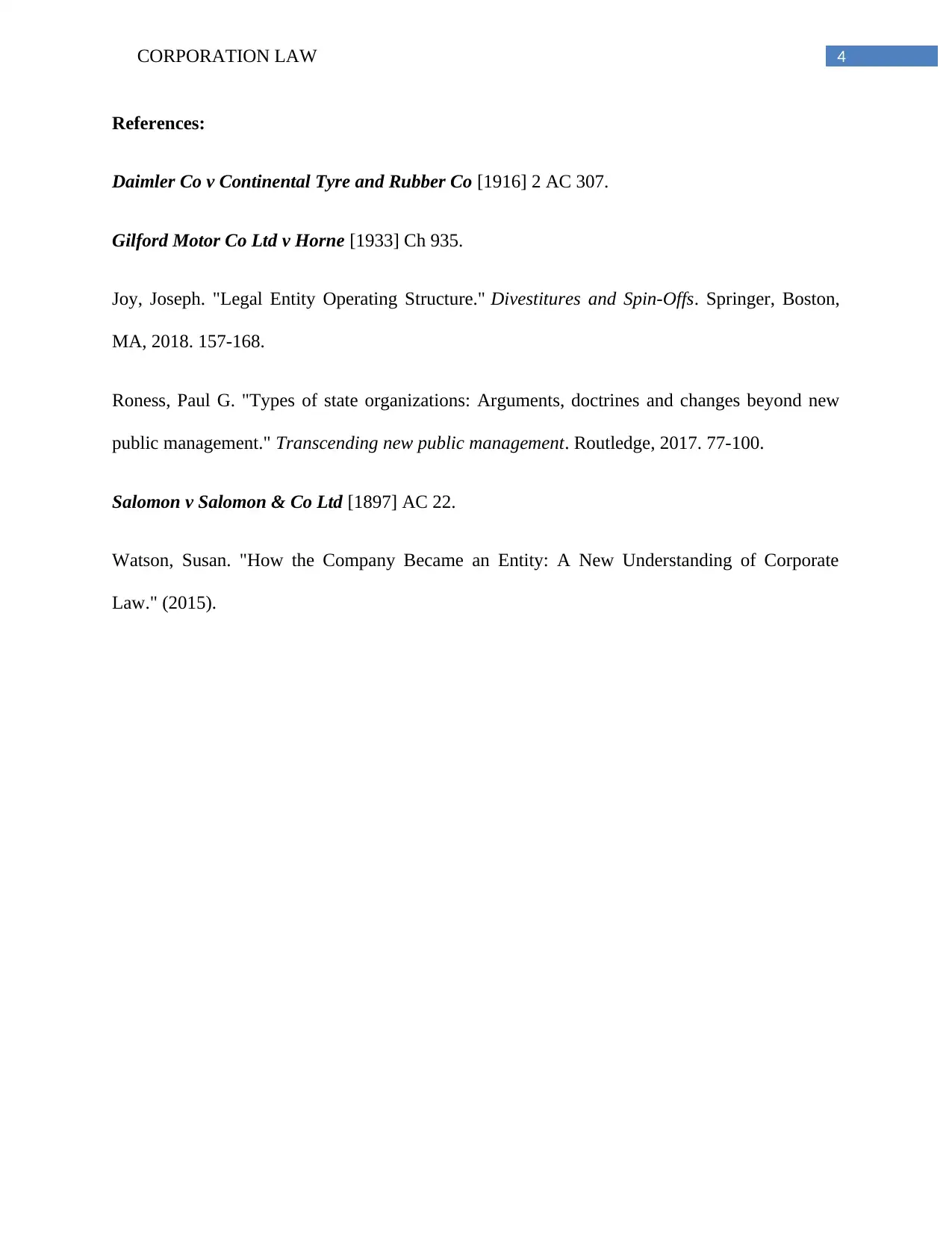
4CORPORATION LAW
References:
Daimler Co v Continental Tyre and Rubber Co [1916] 2 AC 307.
Gilford Motor Co Ltd v Horne [1933] Ch 935.
Joy, Joseph. "Legal Entity Operating Structure." Divestitures and Spin-Offs. Springer, Boston,
MA, 2018. 157-168.
Roness, Paul G. "Types of state organizations: Arguments, doctrines and changes beyond new
public management." Transcending new public management. Routledge, 2017. 77-100.
Salomon v Salomon & Co Ltd [1897] AC 22.
Watson, Susan. "How the Company Became an Entity: A New Understanding of Corporate
Law." (2015).
References:
Daimler Co v Continental Tyre and Rubber Co [1916] 2 AC 307.
Gilford Motor Co Ltd v Horne [1933] Ch 935.
Joy, Joseph. "Legal Entity Operating Structure." Divestitures and Spin-Offs. Springer, Boston,
MA, 2018. 157-168.
Roness, Paul G. "Types of state organizations: Arguments, doctrines and changes beyond new
public management." Transcending new public management. Routledge, 2017. 77-100.
Salomon v Salomon & Co Ltd [1897] AC 22.
Watson, Susan. "How the Company Became an Entity: A New Understanding of Corporate
Law." (2015).
1 out of 5
Related Documents
Your All-in-One AI-Powered Toolkit for Academic Success.
+13062052269
info@desklib.com
Available 24*7 on WhatsApp / Email
![[object Object]](/_next/static/media/star-bottom.7253800d.svg)
Unlock your academic potential
Copyright © 2020–2025 A2Z Services. All Rights Reserved. Developed and managed by ZUCOL.





